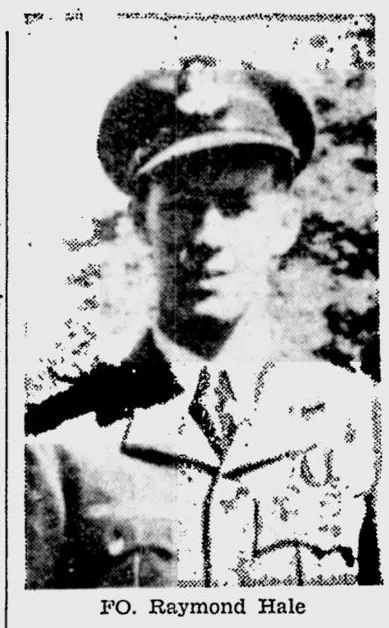Cartier, Joseph Lionel Louis (Flying Officer)
Prisoner of War 1944-December-24


Birth Date: unkown date
Born:
Parents:
Spouse:
Home:
Enlistment:
Enlistment Date: unkown date
Service
RCAF
Unit
419 (B) Sqn- Squadron
Moosa Aswayita Beware of Moose
Base
RAF Middleton St. George
Rank
Flying Officer
Position
Bomb Aimer
Service Numbers
J/39257
Target
Crew or Other Personnel
Lancaster KB715
Mission
Lancaster Mk.X KB715
Bombing Lohausen Germany 1944-December-24 to 1944-December-24
419 (B) Sqn (RCAF) Middleton St. George
338 aircraft - 248 Halifaxes, 79 Lancasters, I I Mosquitoes - of 4, 6 and 8 Groups attacked the airfields at Lohausen and Millheim (now Diisseldorf and Essen civil airports). The purpose of the raids was not recorded; it is possible that they were to hinder the movement of supplies by transport aircraft from the Ruhr to the Ardennes battle area. Both attacks took place in conditions of good visibility and the bombing was accurate. 6 aircraft lost - 2 Lancasters and I Halifax from the Lohausen raid and 3 Halifaxes from the Millheim raid
source: The Bomber Command War Diaries, Martin Middlebrook and Chris Everitt
419 Moose Squadron (Moosa Aswayita). Lancaster aircraft KB 715 was hit by flak, set on fire, and three engines were knocked out during a daylight raid on the Lohausen aerodrome at Dusseldorf, Germany. The aircraft went out of control and the bomb load could not be dropped so Flying Officer Cowtan ordered the crew to bail out. Seven Canadians, F/Os T.H. Cowtan, J.L. Cartier, Hale, Pilot Officer J.V. Ranson, Sergeants C.W. Thompson, G. Little, and Hector were taken Prisoners of War. Flying Officer Hale was executed by the Gestapo the same day as the operation. He was initially buried in Neuss Cemetery. Reinterred 19 April 1947.
Sergeant Little RCAF and Sergeant Hector RCAF were captured on 24 December 1944 at Dusseldorf, part of Trupp 57. They arrived at Bankau on 9 January 1945. (The Long Road - Oliver Clutton-Brock)Pilot: J/29777 Fg Off Thomas Henry Cowtan RCAF - was captured on 24 December 1944 at Dusseldorf. PoW/Krefeld Airfield/Dulag Luft Oberursel Dulag Luft Wetzlar/Stalag Luft 1 Barth Vogelsang/PoW Number?
Flight Engineer: J/89040 Plt Off James Valentine Ranson RCAF - was captured on 24 December 1944 at Dusseldorf. PoW/Injured/Stalag VII J Krefeld/Dulag Luft Oberursel/Dulag Luft Wetzlar/Oflag III Nuremberg/Marched to Stalag VIIA Moosburg 4 April 1945 - 18 April 1945.
Navigator: R/180068 Sergeant Colin Wray Thompson RCAF - was captured on 24 December 1944 at Dusseldorf. PoW/Krefeld Airfield/Dulag Luft Oberursel/Dulag Luft Wetzlar /Stalag Luft 1 Barth Vogelsang/PoW Number?
Bomb Aimer: J/39257 Fg Off Joseph Lionel Louis Cartier RCAF - was captured on 24 December 1944 at Krefeld. PoW/Injured/Krefeld Airfield/Dulag Luft Wetzlar/Stalag Luft 1 Barth Vogelsang/PoW Number?
Sergeant Little RCAF and Sergeant Hector RCAF were captured on 24 December 1944 at Dusseldorf, part of Trupp 57. They arrived at Bankau on 9 January 1945. (The Long Road - Oliver Clutton-Brock)
Mid Upper Gunner: R/265557 Sergeant George Burten Little RCAF - PoW/Stalag Luft 7 Bankau near Kreuzburg Upper Silesia/Stalag 3A Luckenwalde/PoW Number 1336.
Rear Gunner: R/114679 Sergeant Ferdinand Albert Hector RCAF - PoW/Stalag Luft 7 Bankau near Kreuzburg Upper Silesia/Stalag 3A Luckenwalde/PoW Number 1327.source: John Jones
Lancaster serial: KB715

Canadian Warplane Heritage Museum
The Avro Lancaster is a British Second World War heavy bomber. It was designed and manufactured by Avro as a contemporary of the Handley Page Halifax, both bombers having been developed to the same specification, as well as the Short Stirling, all three aircraft being four-engined heavy bombers adopted by the Royal Air Force (RAF) during the same wartime era.
The Lancaster has its origins in the twin-engine Avro Manchester which had been developed during the late 1930s in response to the Air Ministry Specification P.13/36 for a capable medium bomber for "world-wide use". Originally developed as an evolution of the Manchester (which had proved troublesome in service and was retired in 1942), the Lancaster was designed by Roy Chadwick and powered by four Rolls-Royce Merlins and in one version, Bristol Hercules engines. It first saw service with RAF Bomber Command in 1942 and as the strategic bombing offensive over Europe gathered momentum, it was the main aircraft for the night-time bombing campaigns that followed. As increasing numbers of the type were produced, it became the principal heavy bomber used by the RAF, the Royal Canadian Air Force (RCAF) and squadrons from other Commonwealth and European countries serving within the RAF, overshadowing the Halifax and Stirling. Wikipedia
Unit Desciption
419 (B) Sqn Moosa Aswayita ("Moose")
History of the Squadron during World War II (Aircraft: Wellington IC, III, Halifax II, Lancaster X)
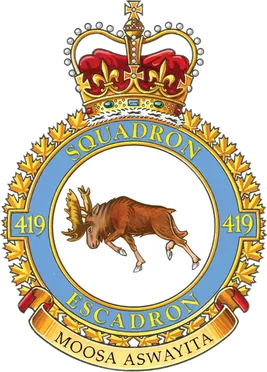
419 (Bomber) Squadron formed at RAF Mildenhall, Suffolk, UK ![]() in 1941 as part of No 3 Group of Bomber Command. It got its name from its first commanding officer, Wing Commander John "Moose" Fulton, DSO, DFC, AFC. The squadron operated Vickers Wellington, then Handley Page Halifax and finally Avro Lancaster bombers through the course of WWII, with the squadron code letters VR. It was the third RCAF bomber unit to be formed in England. It started operations in January 1942, converting almost immediately from Wellington Mk ICs to Wellington Mk IIIs and then moving north to Leeming, Yorkshire,
in 1941 as part of No 3 Group of Bomber Command. It got its name from its first commanding officer, Wing Commander John "Moose" Fulton, DSO, DFC, AFC. The squadron operated Vickers Wellington, then Handley Page Halifax and finally Avro Lancaster bombers through the course of WWII, with the squadron code letters VR. It was the third RCAF bomber unit to be formed in England. It started operations in January 1942, converting almost immediately from Wellington Mk ICs to Wellington Mk IIIs and then moving north to Leeming, Yorkshire, ![]() as part of 4 Group Bomber Command in August 1942. After short stays at Topcliffe
as part of 4 Group Bomber Command in August 1942. After short stays at Topcliffe ![]() and Croft
and Croft ![]() , it moved to Middleton St. George, County Durham
, it moved to Middleton St. George, County Durham ![]() in November 1942, from which it flew until the end of hostilities. Here in November 1942 it was re-equipped with Halifax Mk IIs, which it flew for the next 18 months on the night offensive against Germany. In January 1943 it joined the newly formed 6 (RCAF) Group of Bomber Command.
in November 1942, from which it flew until the end of hostilities. Here in November 1942 it was re-equipped with Halifax Mk IIs, which it flew for the next 18 months on the night offensive against Germany. In January 1943 it joined the newly formed 6 (RCAF) Group of Bomber Command.
In April 1944 the squadron began to convert to the Avro Lancaster Mk X, which was produced in Canada and flown across the Atlantic. The squadron remained continuously on the offensive until 25 April 1945, when it flew its last sortie. Squadron personnel flew a total of 4,325 operational sorties during the war from Mannheim to Nuremberg, Milan to Berlin and Munich to Hanover, inflicting heavy damage on the enemy. On completion of the war in Germany, the squadron was earmarked to become part of the proposed "Tiger Force" to continue the war against Japan. However, the Japanese surrender in August 1945 led to the disbandment of the squadron in at Yarmouth, Nova Scotia ![]() September 1945.
September 1945.
As a result of its wartime record, 419 Squadron became one of the most decorated units under the RCAF during the war. Over a span of roughly three-and-a-quarter years it logged 400 operational missions (342 bombing missions, 53 mining excursions, 3 leaflet raids and 1 "spoof") involving 4,325 sorties. A total of one hundred and twenty nine aircraft were lost on these operations. Members of the squadron accumulated 1 VC, 4 DSO's, 1 MC, 150 DFC's, 3 bars to DFC, 1 CGM, 35 DFM's: the VC was awarded posthumously to Flight Sergeant Andrew Mynarski for his attempts to help a fellow crew member escape from their burning aircraft. Battle Honours were: English Channel and North Sea 1942-44, Baltic 1942-44, Fortress Europe 1942-44, France and Germany 1944-45, Biscay Ports 1942-44, Ruhr 1942-45, Berlin 1943-44, German Ports 1942-45, Normandy 1944, Rhine, Biscay 1942; 1944. Wikipedia, Kostenuk and Griffin
![]() Squadron History (Bomber Command Museum)
Squadron History (Bomber Command Museum)
Maps for Movements of 419 Squadron 1941-45
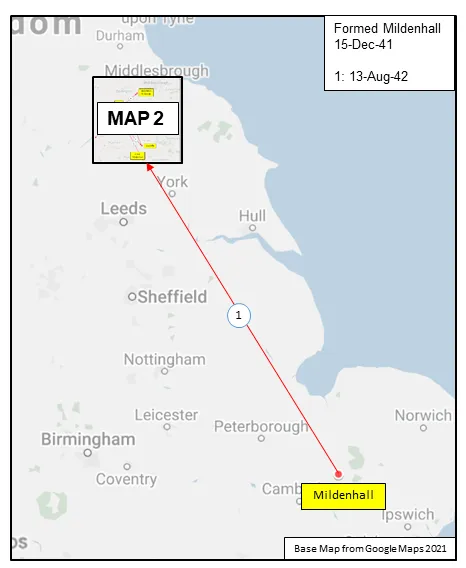
MAP 1: 419 Squadron Movements Dec 1941-Aug-42 (right-click on image to display enlarged new tab)
|
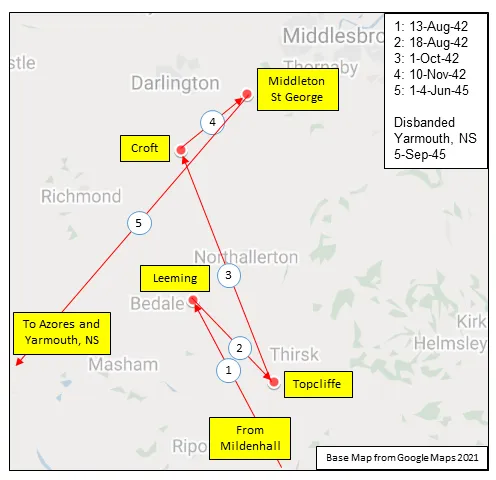
MAP 2: 419 Squadron Movements Aug 1942-Jun 1945
|
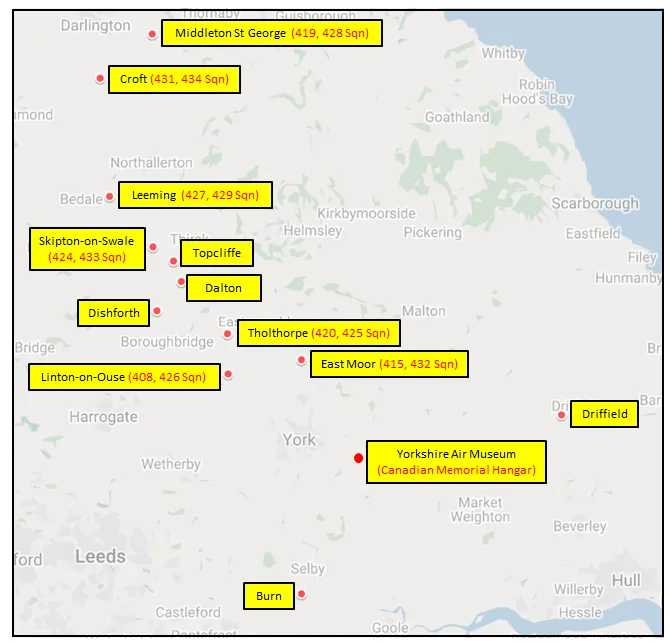
MAP 3: 6 Group Bomber Bases 1943-1945
|
419 Squadron History Summary 1941-45
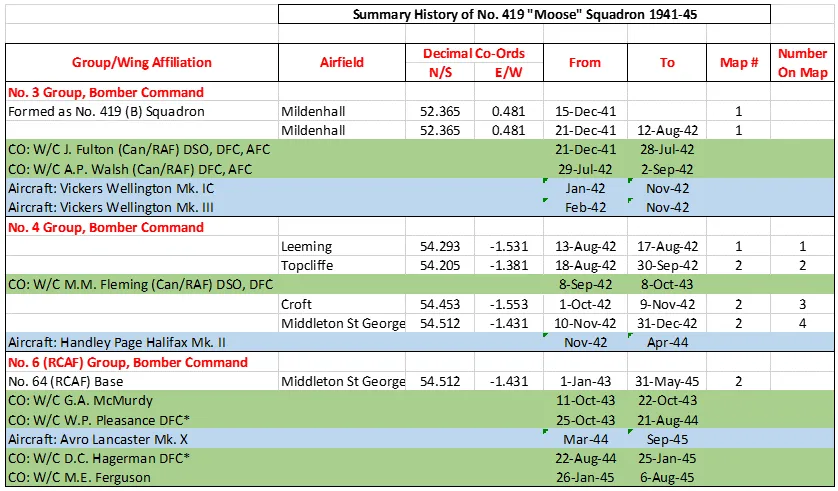
419 Squadron History Summary 1941-45 Page 2

History of the Squadron Post-WWII (Aircraft: Canuck, Silver Star, Freedom Fighter, Hornet)
The squadron was reactivated on 15 March 1954 at North Bay, Ontario ![]() , as an all-weather fighter squadron flying the CF-100 Canuck. It moved to the NATO Air Division base at Baden-Soellingen, Germany
, as an all-weather fighter squadron flying the CF-100 Canuck. It moved to the NATO Air Division base at Baden-Soellingen, Germany ![]() shortly after being formed. The squadron remained there until its disbandment in December 1962.
shortly after being formed. The squadron remained there until its disbandment in December 1962.
The squadron was again re-formed in December 1970, when it relocated to Cold Lake, Alberta ![]() as No. 1 Canadian Forces Flight Training School. It initially flew the T-33 Silver Star but then transitioned to the Canadair CF-5 Freedom Fighter. The squadron was on full active duty in November 1975 but disbanded again 20 years later when the CF-5’s were retired in June 1995.
as No. 1 Canadian Forces Flight Training School. It initially flew the T-33 Silver Star but then transitioned to the Canadair CF-5 Freedom Fighter. The squadron was on full active duty in November 1975 but disbanded again 20 years later when the CF-5’s were retired in June 1995.
The squadron was again reactivated as 419 Tactical Fighter (Training) Squadron on 23 July 2000. The squadron has since conducted Phase IV of the NATO Flying Training Canada (NFTC) program for the air forces of Canada, Austria, Denmark, Italy, Hungary, Saudi Arabia, Singapore, the United Arab Emirates and the United Kingdom. This program trains basic jet pilots to become fighter pilots and prepares them for training on CF-188 class aircraft through instruction in Air-to-Air and Air-to-Ground combat tactics over a six month period.
